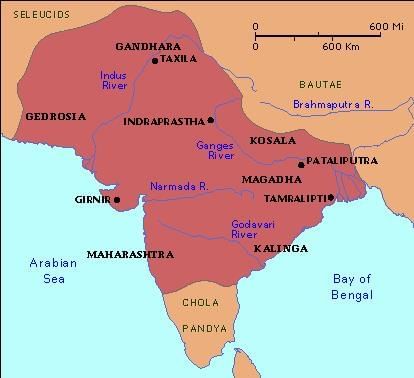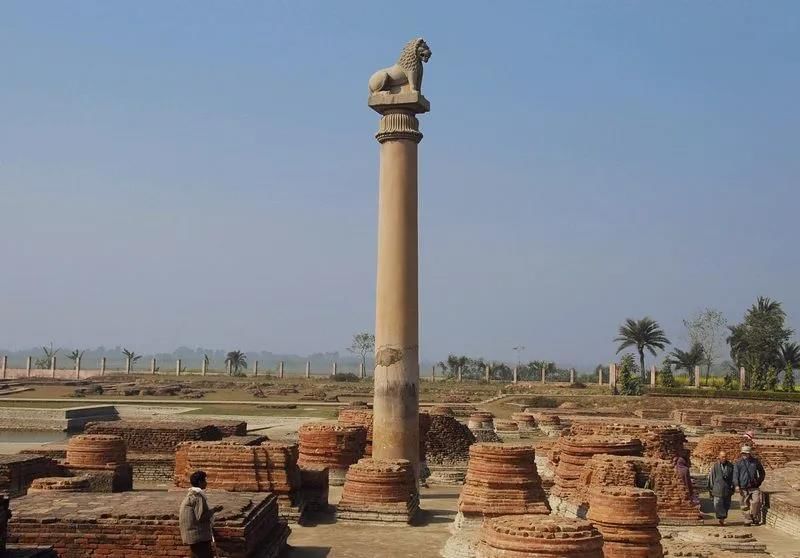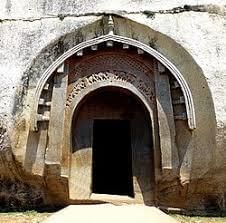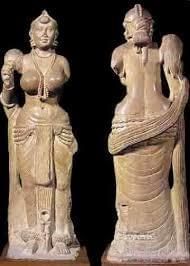Art, Architecture & Causes of Decline: The Mauryan Empire | History for UPSC CSE PDF Download
| Table of contents |

|
| Origin of Mauryan Architecture |

|
| Key Features of Mauryan Architecture |

|
| Materials Used in Construction |

|
| Stupas |

|
| Pillars |

|
| Palaces |

|
| Caves |

|
| Sculptures |

|
| Causes of Decline of Mauryan Empire |

|
The Mauryan period marked a significant phase in the evolution of Indian architecture. Flourishing between the 4th and 3rd centuries BCE, this era saw the emergence of a grand architectural tradition shaped by the wealth of the Mauryan Empire and the spiritual rise of Buddhism and Jainism. With royal patronage and new religious ideas, the Mauryan rulers—especially Emperor Ashoka—laid the foundation for some of the most iconic architectural styles and structures in ancient India.
Origin of Mauryan Architecture
- Mauryan architecture began between the 4th and 3rd centuries BCE.
- It developed due to the wealth of the Mauryan Empire and the growing influence of Buddhism and Jainism, which brought a new spiritual outlook.
Key Features of Mauryan Architecture
Influences and Style
- The style was influenced by Persian and Greek architecture.
- Most surviving structures are from Ashoka’s reign, except for a few remains of Chandragupta Maurya’s palace at Pataliputra.
- Mauryan architecture is broadly classified into: Palaces, Stupas, Pillars and Cave structures
Pataliputra – The Capital City
- Greek ambassador Megasthenes called the city Palibothra and described it as a parallelogram.
- The city was protected by wooden fortifications with 570 towers and 64 gates.
- A wide and deep moat surrounded the city, serving both as defense and drainage system.
Materials Used in Construction
- Even though brick and stone work had advanced greatly, wood remained the most commonly used material.
- Stone was used for:
- Tall standalone pillars
- Stupa railings
- Thrones
- Large sculptures and figures
Art and Architecture of Mauryan Period
- There are no surviving ancient monuments of significant artistic value from the period before the Mauryas.
- The buildings, palaces, and monuments of Chandragupta have perished as they were mostly made of wood.
- The artistic remains of the Ashokan period may be described under the four heads: (a) Stupas (b) Pillars (c) Palaces (d) Caves
Stupas
- Stupas are solid, dome-shaped burial monuments made of brick or stone, typically resting on a circular base.
- Originated in the Vedic period, but became prominent during Ashoka’s reign.
- The primary purpose was to enshrine relics of the Buddha or great Buddhist saints, or to commemorate sacred places.
- After Buddha’s death, nine stupas were built; initially, only one housed his relics, but later they were distributed among all.
Architectural Features
- The inner wall was built using unburnt bricks, and the outer wall with burnt bricks coated in plaster.
- A circular terrace called Medhi surrounded the stupa.
- Cardinal gateways, called Toranas, were decorated and often topped with a wooden umbrella symbolizing Dharma.
- A Parikrama path (circumambulatory path) encircled the stupa for ritual walking.
 Stupa
Stupa
Sanchi Stupa – Most Famous Example
- Located in Sanchi, Madhya Pradesh, built under Ashoka’s patronage.
- Built as a hemispherical dome, which is solid and cannot be entered.
- Features upright pillars and crossbars, influenced by wooden construction.
- Carvings depict Buddhist symbols like the lotus, elephant, bull, lion, and horse.
- Jataka tales (stories from Buddha’s previous lives) are shown in low relief sculptures with detailed artistry.
Other Important Stupa
The oldest stupa is the Piprahwa Stupa in Uttar Pradesh.
Pillars
- Ashokan pillars are a remarkable achievement in ancient Indian engineering, architecture, and sculpture.
- Each pillar was about 15 metres high and weighed nearly 50 tonnes.
- Carved from Chunar sandstone, the material was sourced from the Chunar quarries.
- These were free-standing stone columns, not used to support any structure.
- On average, they stood 40 feet tall and were placed throughout the Indian subcontinent.
 Ashokan Pillar
Ashokan Pillar
Structural Features
- The pillars were composed of four main parts:
- Shaft – a single monolithic column, often polished, made of Chunar sandstone.
- Capital – placed above the shaft, often lotus-shaped or bell-shaped.
- Abacus – a circular or rectangular slab above the capital.
- Animal Figure – placed at the top, often a lion or elephant, symbolizing strength and authority.
The pillar capitals also featured:
- Finely sculpted animal figures (e.g., lion, elephant).
- The Dharmachakra (Wheel of Dharma) engraved with detailed carvings.
- The inverted lotus, symbolizing purity and spiritual growth.
Purpose and Inscriptions
- The teachings of Dhamma (moral code of Buddhism) were inscribed on many of these pillars.
- The inscriptions often spread messages of peace, tolerance, and non-violence.
- Some pillars were used to mark the stages of Ashoka’s pilgrimage to various Buddhist sites.
Palaces
- The palaces of the Mauryan Empire were known for their grandeur, elegance, and artistic excellence.
- Greek historian Megasthenes described them as “the greatest creations of mankind.”
- Chinese traveler Fa Hien referred to them as “god-gifted monuments.”
- Greek writers of the time considered the palaces at Pataliputra among the finest and grandest in the world.
Persian Influence
- The palace of Chandragupta Maurya was influenced by Achaemenid palaces at Persepolis in Iran.
- The architectural style showed a blend of Indian design and Persian precision.
Material Used
- Wood was the primary building material used in constructing Mauryan palaces.
- Despite being grand, much of the architectural evidence has not survived due to the perishable nature of wood.
Archaeological Evidence
- Excavations near Patna (ancient Pataliputra) have revealed ruins of Mauryan buildings.
- Among the most remarkable discoveries is the remains of the “hundred-pillared hall.”
Notable Examples
- Chandragupta Maurya’s palace at Pataliputra.
- Ashoka’s palace at Kumrahar, believed to be part of the capital complex.
Caves
- The caves were cut out of hard and refractory rocks.
- Their interior walls are so well-polished that they shine like mirrors.
- These were meant to be the residences for monks and also served the purpose of churches and assembly halls.
- A lot of such caves are found on the Nagarjuna hills and Barabar hills near Gaya.
 Barabar Caves
Barabar Caves
Sculptures
- Mauryan sculpture reflects a high level of artistic excellence and craftsmanship.
- The most famous examples include the figures of Yaksha and Yakshi, which were worshipped in Jainism, Hinduism, and Buddhism.
- The Didarganj Yakshi, discovered in Didarganj near Patna, is a notable example of early Indian sculpture.
- The Lohanipur torso, a nude male figure found in Patna, also belongs to this period and showcases advanced sculptural technique.
- The earliest literary mention of Yakshi is found in the Tamil epic Silappadikaram.
- Animal figures like lions, horses, and graceful deer carved on the Ashokan pillars are masterpieces of Mauryan sculpture and indicate royal symbolism, elegance, and power.
 Sculptures of Mauryan Period
Sculptures of Mauryan Period
Pottery
- Pottery from the Mauryan era is generally referred to as Northern Black Polished Ware (NBPW).
- This type of pottery is noted for its black paint, glossy surface, and refined finish.
- NBPW was mostly used as luxury ware, indicating its value among the elite.
- Kosambi and Pataliputra were major centers for NBPW production during the Mauryan period.
Few terms of Mauryan period
1. Weights and Measures: Pautava
2. Slaughter house: Suna
3. Gambling: Dyuta
4. Port: Paltana
5. Passports: Mudra
6. Agriculture: Sita
7. Spinning and Weaving Industry: Sutra
8. Forest products: Kupya
9. Commerce: Panya
10. Accountant general in charge of the two offices of Currency and Accounts: Akshapataladhyaksha
11. Director of Agriculture: Sitadyaksha
12. Pulses: Mudga and Masha
13. Linseed: Kalaya, Atasi
14. Mustard: Sharshapa
15. Wheat: Godhuma
16. Sugarcane: Ikshu
17. Fodder: Haritaka
18. Gardens: Vata
19. Superintendent of Mines: Akaradhyaksha
20. Warden of Marches: Antapala
21. Disabled Women: Nayanga
22. Jute: Kshuma
23. Silka: Dukula
24. Wool of deer: Rankava
25. Cotton: Karpasa
26. Grazing ground for cattle: Vraja
27. Wool: Rauma
28. Nalika: was equal to 24 minutes
Terms related to Revenue
1. Sita: Crown land
2. Bhaga: the share of agriculture produce payable to the state as revenue.
3. Bali: A general land tax
4. Kara: Tax on orchards
5. Vanik: Tax on merchandise
6. Tara: Ferry charges
7. Nava: Tax payable to the superintendent of shipping
8. Vivita: Tax on pasture-lands
9. Vartani: Road cess
10. Rajju: Cess payable for settlement to the rural offices called Vishaya-pala.
11. Chora-Rajju: Police tax to be collected at the village.
Causes of Decline of Mauryan Empire
1. Weak Successors and Political Fragmentation
- After Ashoka, the empire saw a rapid succession of weak rulers who lacked both vision and leadership.
- The empire began to fragment, and regional rulers gained autonomy.
- Successors ruled for short periods, failing to maintain existing governance structures or introduce new ones.
- The central authority weakened, reducing administrative efficiency and unity.
2. Administrative Challenges
- Dhamma-Mahamattas, introduced by Ashoka, may have become oppressive and too powerful in later years.
- The increasing number of officials owed loyalty to individual kings instead of the state, creating instability.
- The spy system, which was essential to maintaining control, collapsed, leading to widespread corruption.
3. Economic Decline
- The state monopoly on metals declined, and iron supply from Magadha could not meet the expanding needs of agriculture and military.
- Deforestation and overuse of resources led to ecological problems like floods and famines—a major famine occurred in North Bengal.
- Centralized administration suffered from declining revenues, leading to over-taxation.
- The Arthashastra even recommended taxing non-traditional groups like actors and prostitutes to raise funds.
4. Scholarly Interpretations
- . H.P. Sastri states that Ashoka’s patronage to Buddhism, his disregard to ritualism and sacrifices, his appointment of Dhamma-Mahamatras and deliberate humiliation of the Mahamatras etc. gave rise to a reaction which was carried to success by the Brahmana Commander-in-Chief Pushyamitra.
- Another school of historians point out that the basic cause of the down-fall was Ashoka’s policy of Ahimsa or non-violence which reduced the martial spirit of soldiers and thereby the fighting strength of army which ultimately made it incapable to fight against the Greek invaders or suppress the revolts of provincial governers. Dr. H.C. Raychaudhary has supported this view.
- According to Kausambi the primary cause was its financial weakness.
- The succession of weak kings after Ashoka and division of the empire into two parts, were the causes of the decline.
- Dr. Romila Thapar puts forth the view that the absence of the ideal of one state or one nation were responsible for the down fall of the Mauryas.
- The Greek invasion of the north-west, which could not be checked due to political disunity, was yet another important factor.
|
216 videos|855 docs|219 tests
|
FAQs on Art, Architecture & Causes of Decline: The Mauryan Empire - History for UPSC CSE
| 1. What was the significance of art and architecture during the Mauryan Empire? |  |
| 2. What were the main architectural features of the Mauryan Empire? |  |
| 3. How did art and architecture reflect the decline of the Mauryan Empire? |  |
| 4. What were the causes of the decline of the Mauryan Empire? |  |
| 5. How did the decline of the Mauryan Empire impact its art and architecture? |  |





















